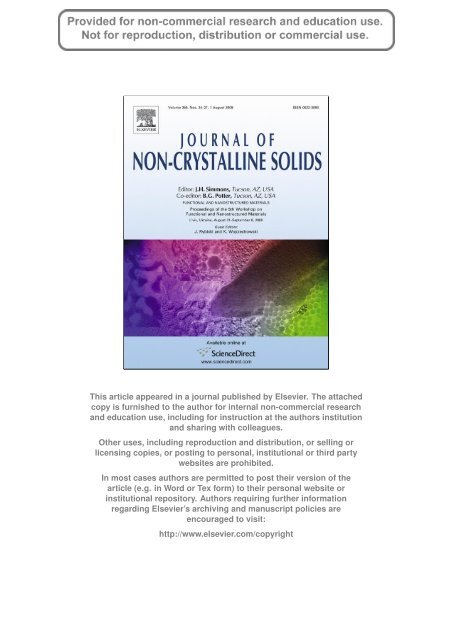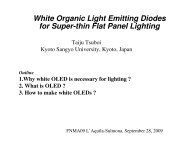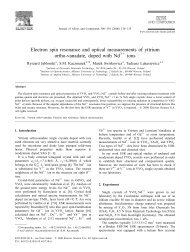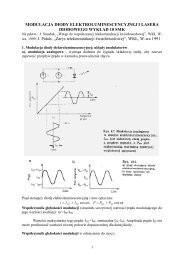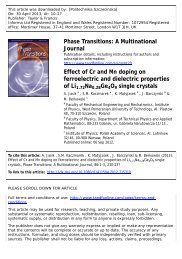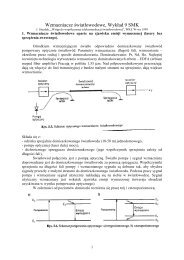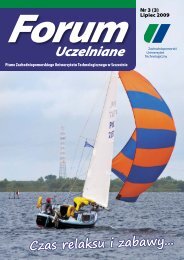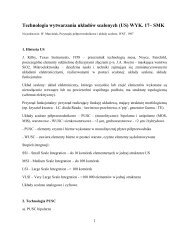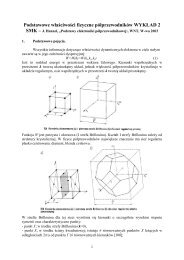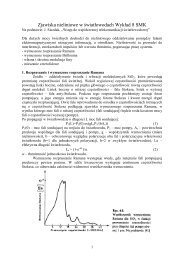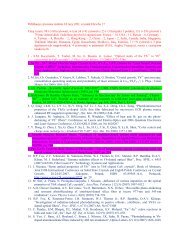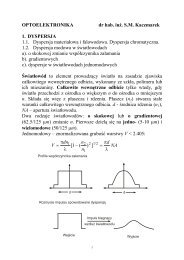Author's personal copy - West Pomeranian University of Technology
Author's personal copy - West Pomeranian University of Technology
Author's personal copy - West Pomeranian University of Technology
You also want an ePaper? Increase the reach of your titles
YUMPU automatically turns print PDFs into web optimized ePapers that Google loves.
This article appeared in a journal published by Elsevier. The attached<br />
<strong>copy</strong> is furnished to the author for internal non-commercial research<br />
and education use, including for instruction at the authors institution<br />
and sharing with colleagues.<br />
Other uses, including reproduction and distribution, or selling or<br />
licensing copies, or posting to <strong>personal</strong>, institutional or third party<br />
websites are prohibited.<br />
In most cases authors are permitted to post their version <strong>of</strong> the<br />
article (e.g. in Word or Tex form) to their <strong>personal</strong> website or<br />
institutional repository. Authors requiring further information<br />
regarding Elsevier’s archiving and manuscript policies are<br />
encouraged to visit:<br />
http://www.elsevier.com/<strong>copy</strong>right
<strong>Author's</strong> <strong>personal</strong> <strong>copy</strong><br />
Spectral and magnetic properties <strong>of</strong> macroacyclic and macrobicyclic<br />
Schiff base RE complexes<br />
S.M. Kaczmarek *, G. Leniec<br />
Institute <strong>of</strong> Physics, <strong>West</strong> <strong>Pomeranian</strong> <strong>University</strong> <strong>of</strong> <strong>Technology</strong>, Al. Piastów 17, 70-310 Szczecin, Poland<br />
article info<br />
Article history:<br />
Available online 10 June 2009<br />
PACS:<br />
76.30._v<br />
75.30.Hx<br />
76.30.Kg<br />
Keywords:<br />
Magnetic properties<br />
1. Introduction<br />
abstract<br />
Macrocyclic compounds are interesting because <strong>of</strong> their ability<br />
to form complexes with transition metal ions and rare-earths (RE).<br />
Over the last decade, sustained research activity devoted to lanthanide<br />
ions and their macrocyclic and macrobicyclic complexes has<br />
to some extent resulted from successful applications <strong>of</strong> these compounds<br />
in the industry, medicine and biology. Such macroacyclic<br />
compounds as podands have a higher flexibility <strong>of</strong> arms and their<br />
complexation ability grows with the ionic radius <strong>of</strong> rare-earth ions.<br />
The formation <strong>of</strong> macrobicycle compounds (such as cryptates) depends<br />
to a large extent on the accuracy <strong>of</strong> the cation fit in the ligand<br />
cavity. They are more rigid than macroacyclic compounds.<br />
Lanthanide ions can be used in the design <strong>of</strong> novel fluorescent<br />
probes, luminescence labels (detecting small amounts <strong>of</strong> biomolecules<br />
that can provide information about the patient’s physical<br />
condition) <strong>of</strong> biomedical interest [1]. Macrocyclic complexes based<br />
on RE ions can imitate the complicated structure <strong>of</strong> an enzyme,<br />
they are however significantly smaller and simpler. They are applied<br />
to cure leukemia, they have antivirus activity (Oxphaman),<br />
they are used in medical diagnostics, treatment <strong>of</strong> arteriosclerosis,<br />
radioimmunology, as the contrast medium, as a synthetic enzyme<br />
to split a nucleic acid chain [2–4]. They reveal bactericidal, mycosicidal<br />
and nailicidal properties.<br />
* Corresponding author. Tel.: +48 914494887; fax: +48 914494181.<br />
E-mail address: skaczmarek@ps.pl (S.M. Kaczmarek).<br />
0022-3093/$ - see front matter Ó 2009 Elsevier B.V. All rights reserved.<br />
doi:10.1016/j.jnoncrysol.2009.05.020<br />
Journal <strong>of</strong> Non-Crystalline Solids 355 (2009) 1325–1332<br />
Contents lists available at ScienceDirect<br />
Journal <strong>of</strong> Non-Crystalline Solids<br />
journal homepage: www.elsevier.com/locate/jnoncrysol<br />
IR spectroscopic, electrospray ionization mass spectrometry, TG-DTA, structure and magnetic properties<br />
<strong>of</strong> the gadolinium(III), samarium(III) and dysprosium(III) macroacyclic tripodal Schiff base,<br />
C27H27N4O3Cl3Gd(Dy, Sm) as well as gadolinium(III) and erbium(III) cryptate C39H47MN9O6 (M@Gd, Er)<br />
complexes are reported. The positions <strong>of</strong> m(C@N) stretching bonds indicate that the azomethine group<br />
nitrogen is coordinated to the rare earth ion. The [1:1] ligand to metal proportion in all macrocyclic<br />
and mocrobicyclic Schiff base complex samples has been confirmed by both electron ionization and electron<br />
spray molecular spectros<strong>copy</strong> spectra. A TG-DTA analysis has indicated the presence <strong>of</strong> two water<br />
molecules in the inner-sphere <strong>of</strong> the macrobicyclic complex and confirmed that there is no water coordination<br />
<strong>of</strong> the metal ion in the macroacyclic complex. The near neighborhood <strong>of</strong> cation ions in the complexes<br />
<strong>of</strong> both types and their structure have been proposed on the basis <strong>of</strong> the above data. The<br />
temperature dependence <strong>of</strong> the EPR spectra integrated intensity has made it possible to reveal magnetic<br />
interactions in the spin system <strong>of</strong> these compounds.<br />
Ó 2009 Elsevier B.V. All rights reserved.<br />
They can be also applied in preparation <strong>of</strong> new kinds <strong>of</strong> catalysts<br />
and enzymes [5]. The metal ion in macrocyclic compounds<br />
locates itself inside a cavity formed by rings and aliphatic arms.<br />
Hence, the compounds are used in chemical analysis and synthesis<br />
to fix an aminoacid composition, to detect finger traces, to<br />
separate selected metals and supramolecular devices. Macrobicyclic<br />
ligands can find potential application in selective extraction<br />
<strong>of</strong> metals.<br />
Moreover, they can find extensive application in optoelectronics<br />
as photoluminescence materials, as nonlinear optical materials<br />
(e.g. N-(R-salicylideno)-R 0 -anilin), as reversive optical storage, solar<br />
filters, photostabilizers, dyes for solar collectors, molecular<br />
switches (due to the photochromic properties) [6].<br />
Schiff bases are macroacyclic (MaSB) or macrobicyclic (MSB)<br />
compounds with an imine group. The general formula <strong>of</strong> a Schiff<br />
base is R-CH@N-R 0 . The chemical and physical properties <strong>of</strong> the<br />
compounds strongly depend on the R and R 0 substituents. The complexes<br />
<strong>of</strong> both types are built <strong>of</strong> one (two) nitrogen atoms that hold<br />
three ligand arms with an azometine group (Schiff base) in each <strong>of</strong><br />
them, two aliphatic arms (CH2), one aromatic ring connected with<br />
chlorine (methyl) on the opposite site and a phenolic group. The<br />
OH phenolic groups within the complex are involved in intramolecular<br />
hydrogen bonds with the respective nitrogen atoms <strong>of</strong> the<br />
Schiff base. When a complex is formed the bonds are broken and<br />
a metal cation ion is adjoined. Macrocyclic and macrobicyclic compounds<br />
have been designed to form [1:1], [1:2] and more metal ion<br />
complexes.
On the basis <strong>of</strong> the performed measurements, we have proposed<br />
in this paper a structure <strong>of</strong> macrobicycle Schiff base complexes with<br />
gadolinium and erbium as well as macroacycle Schiff base complexes<br />
with gadolinium, dysprosium and samarium, giving also<br />
the distances from the RE ion to the closest neighboring ions. The<br />
presented results are characteristic and recurrent for other RE ions<br />
in the above mentioned complexes. The paper is aimed as a minireview,<br />
although semiempirical calculations <strong>of</strong> structures <strong>of</strong> the<br />
above mentioned complexes are presented for the first time.<br />
2. Experimental<br />
A synthesis <strong>of</strong> macroacyclic (MaSB) and macrobicyclic (MSB)<br />
complexes was carried out by condensation <strong>of</strong> appropriate<br />
amine-precursors in the presence <strong>of</strong> lanthanide (III) salts whose<br />
cation is assumed to act as a ring formation template.<br />
A synthesis <strong>of</strong> gadolinium and dysprosium Schiff base podates,<br />
C 27H 27N 4O 3Cl 3M(M@Gd, Dy) was made using the known methods<br />
described for the first time by Liu et al. [7] and Malek et al. [8],<br />
respectively.<br />
A synthesis <strong>of</strong> gadolinium and erbium macrobicyclic cryptate<br />
complexes, C 39H 47MN 9O 6 (M@Gd, Er), was performed according<br />
to [9,10].<br />
The IR spectra <strong>of</strong> a solid compound were recorded on a Brüker<br />
FT-IR IFS 113v spectrophotometer in the region <strong>of</strong> 3500–<br />
400 cm 1 applying MaSB and MSB complex powder mixed with<br />
KBr and pressed into pellets and complex powder immersed in<br />
oil and placed between CaF 2 plates. The Schiff base ligand and gadolinium<br />
complex spectra were recorded at room temperature (RT)<br />
with the resolution <strong>of</strong> 2 cm 1 .<br />
A mass spectros<strong>copy</strong> analysis was performed using the following<br />
devices: the electron ionization (EI) mass spectrum <strong>of</strong> the measured<br />
samples was registered using the AMD 604 system (EI 70 eV,<br />
Temp = 346 K); the Mariner <strong>of</strong> PE Biosystems spectrometer operating<br />
with a TOF detection system was used for the electron spray<br />
(ES) mass spectrum (MeOH solution, positive ions, NP = 400). The<br />
ESI mass spectra were recorded on a waters/micromass (Manchester,<br />
UK) ZQ mass spectrometer equipped with a Harvard Apparatus<br />
syringe pump. The sample solution was prepared in a mixture <strong>of</strong><br />
acetonitrile and methanol (1:1).<br />
The DTA measurements were taken using a METTLER, STAR e SW<br />
8.10 derivatograph. The TG-DTA analysis was performed in an N2<br />
atmosphere with a heating rate <strong>of</strong> 10 K/min in the range <strong>of</strong> 300–<br />
600 K. The investigated powder sample mass was 390 000 mg.<br />
The electron paramagnetic resonance (EPR) spectra were recorded<br />
on a conventional X-band Bruker ELEXSYS E 500 CW-spectrometer<br />
operating at 9.5 GHz with a 100 kHz magnetic field<br />
modulation. The investigated samples were in a fine powder form.<br />
The first powder absorption spectra derivative was recorded as a<br />
function <strong>of</strong> the applied magnetic field. The EPR spectra temperature<br />
dependence in the 3–300 K temperature range was registered<br />
using an Oxford Instruments ESP helium-flow cryostat. The temperature<br />
dependence analysis <strong>of</strong> the following spin-Hamiltonian<br />
parameters was conducted: the EPR integrated intensity, calculated<br />
as a double integral <strong>of</strong> the EPR signal proportional to the<br />
imaginary part <strong>of</strong> the spin system’s complex magnetic susceptibility;<br />
the g-factor, reciprocal <strong>of</strong> the integrated intensity, and the<br />
product <strong>of</strong> T Iint which was proportional to the square <strong>of</strong> the spin<br />
system magnetic moment. All the registered EPR spectra <strong>of</strong> the<br />
investigated complexes were simulated using the EPR–NMR computer<br />
program in order to study the above mentioned spin-Hamiltonian<br />
parameters. The anisotropic g-factors were calculated using<br />
the SIMPOW s<strong>of</strong>tware package [11] in the temperature range <strong>of</strong> 3–<br />
55 K to extract the symmetry <strong>of</strong> the crystal field acting on the cation<br />
ion in the complex.<br />
<strong>Author's</strong> <strong>personal</strong> <strong>copy</strong><br />
1326 S.M. Kaczmarek, G. Leniec / Journal <strong>of</strong> Non-Crystalline Solids 355 (2009) 1325–1332<br />
3. Results and discussion<br />
3.1. Structure <strong>of</strong> MSB and MaSB ligands<br />
Generally speaking, the complexes between a Schiff (MSB or<br />
MaSB) base macrocycle or its derivatives and lanthanide ions obtained<br />
by a template synthesis are characterized by high coordination<br />
numbers 7, 8 or 9 in which the coordination sites are<br />
substituted by such counterions as NO3, ClO4, SCN or OAc and<br />
H 2O or by solvent molecules [12–14]. If MSB (MaSB) complexes<br />
or their analogs with lanthanides include a water molecule, they<br />
can be coordinated to the cation or encapsulated in a cage formed<br />
by the ligand [14,15]. The coordination geometry in the complexes<br />
is different and depends on the coordination number, the complex<br />
type and the counterion kind (e.g. eight-coordinated Eu 3+ complexes<br />
are distorted dodecahedrons [14] while the coordination<br />
geometry for nine-coordinated Nd 3+ and Dy 3+ complexes is a<br />
monocapped-square antiprismatic and monocapped-dodecahedron,<br />
respectively [16,17].<br />
The C39H48N8O3 ligand structure is formed by: six aliphatic<br />
chains <strong>of</strong> CH 2, three OH phenolic groups, three CH 3 methyl groups,<br />
six imine C@N groups and two aliphatic nitrogen atoms. The<br />
C 27H 27N 4O 3Cl 3 ligand structure is formed by three aliphatic chains<br />
begining with an aliphatic nitrogen atom, three imine groups, three<br />
aromatic rings, three phenolic groups and three chlorine atoms.<br />
Aromatic rings are joined with aliphatic chains by imine groups.<br />
Phenolic groups and chlorine atoms are adjoined to aromatic rings.<br />
3.2. Infrared spectros<strong>copy</strong><br />
The m(C@N) vibration mode in the Schiff base MSB-Gd 3+ ligand<br />
was observed at 1638 cm 1 and confirmed the bicyclic condensation<br />
reaction with the consequent formation <strong>of</strong> a macrobicycle<br />
Schiff base. It was moved to higher wavenumbers (by about<br />
12 cm 1 ) after complexation. The m(C@N) stretching mode shift towards<br />
higher wavenumbers indicates a stronger double bond nature<br />
<strong>of</strong> the iminic bonds and a coordination <strong>of</strong> the azomethine<br />
group nitrogen to the metal ion [18]. The phenolic m(OH) vibration<br />
was moved towards lower frequencies from 3449 to 3420 cm 1<br />
after complexation (compare Figs. 1 and 2 and Table 1). This indicates<br />
that the phenolic OH oxygen is coordinated to the metal ion.<br />
A band was observed for the complex at 3420 cm 1 which indicates<br />
that there is another water molecule in the complex. In addition<br />
to that, two wide bands assigned to M–N and M–O bonds were<br />
Transmittance [%]<br />
80<br />
70<br />
60<br />
50<br />
40<br />
30<br />
20<br />
10<br />
0<br />
760<br />
870<br />
973<br />
1072<br />
1161<br />
1254<br />
1364<br />
1459<br />
1600<br />
1638<br />
Wavelength [cm -1 ]<br />
2892<br />
2918<br />
MSB - MIR<br />
550 900 1250 1600 2600 3500<br />
Fig. 1. FT-IR trnsmittance spectrum <strong>of</strong> a macrobicyclic (MSB) ligand.<br />
3449
Fig. 2. FT-IR spectrum <strong>of</strong> MSB-Gd 3+ and MSB-Er 3+ complexes pressed into KBr<br />
pellets.<br />
observed in the FIR spectrum <strong>of</strong> the Gd complex at 395–489 cm 1<br />
and 532–590 cm 1 [18–24], respectively.<br />
The MSB-Er 3+ complex spectrum in the KBr pellet shows a broad<br />
band at 3403 cm 1 which can be assigned to m(OH) vibrations<br />
<strong>of</strong> a water molecule hydrogen bonded within the [(MSB-<br />
H+NO 3 +H 2O) Er] + complex [25]. The position <strong>of</strong> this band suggests<br />
that the water molecule within the complex is only weakly<br />
hydrogen bonded which can mean that the water molecule does<br />
not coordinate the metal cation. All the OH phenolic groups within<br />
the complex are involved in intramolecular hydrogen bonds with<br />
the respective nitrogen atoms <strong>of</strong> the Schiff base. Such conclusion<br />
finds confirmation in earlier CP-MAS studies [26] demonstrating<br />
formation <strong>of</strong> OH N intramolecular hydrogen bonds in which the<br />
proton is localized at the oxygen atom as well as in a broad band<br />
in the FT-IR spectrum in the region <strong>of</strong> about 3000–2000 cm 1 . Furthermore,<br />
the appearance <strong>of</strong> two intense bands, assigned to the<br />
m(C@N) vibrations at 1651 and 1638 cm 1 confirms the above<br />
statement. The band at 1651 cm 1 can be assigned to the stretching<br />
vibrations <strong>of</strong> Schiff base group complexes to the Er 3+ cation and<br />
the other band at 1638 cm 1 can be assigned to the intramolecular<br />
hydrogen bonded groups as in a pure ligand. The presence <strong>of</strong> an<br />
NO 3 group as a ligand in the coordinating sphere is indicated by<br />
the appearance <strong>of</strong> a broadened band at ca. 1355 assigned to the<br />
m(NO3) vibrations overlapped with the bands assigned to the<br />
d s(CH 3) vibrations.<br />
When comparing the IR spectra <strong>of</strong> different MSB complexes (Gd,<br />
Er) it can be found that they are very similar to each other.<br />
A m(C@N) stretching bond in the MaSB ligand and in the MaSB-<br />
Gd complex was observed at 1635.2 and 1625 cm 1 , respectively<br />
(see Fig. 3 and Table 2). This indicates that the azomethine group<br />
nitrogen is coordinated to the rare earth ion [27]. The phenolic<br />
m(OH) stretching bond was observed at 3436 and 3432 cm 1 in<br />
the ligand and in the Gd complex, respectively in case <strong>of</strong> the complex<br />
powder mixed with KBr and pressed into pellets. This band<br />
was not observed for powder immersed in a poly(chlorotrifluoro-<br />
<strong>Author's</strong> <strong>personal</strong> <strong>copy</strong><br />
S.M. Kaczmarek, G. Leniec / Journal <strong>of</strong> Non-Crystalline Solids 355 (2009) 1325–1332 1327<br />
ethylene) emulsion placed between CaF2 plates. It indicates that<br />
the phenolic OH group observed in the IR spectrum <strong>of</strong> a MaSB-<br />
Gd complex comes from KBr.<br />
A broad band in the region <strong>of</strong> 3000–2000 cm 1 occurs in the<br />
MaSB spectrum (see Fig. 3). This band is assigned to the stretching<br />
vibrations <strong>of</strong> protons getting involved in the medium-strong intramolecular<br />
N H–O hydrogen bonds [28]. This band is not observed<br />
any longer in the MaSB-Dy 3+ complex spectrum (see Fig. 4) indicating<br />
that all phenolic groups are deprotonated and that they are involved<br />
in the Dy 3+ cation complexation process [29]. Furthermore,<br />
this spectrum indicates that no water molecules are present in the<br />
metal cation coordination sphere, either. It is only one band as a<br />
superposition <strong>of</strong> several bands assigned to m(C@C) <strong>of</strong> aromatic<br />
rings and m(C@N) <strong>of</strong> Schiff base vibrations that appears at<br />
1635 cm 1 in the ligand spectrum in the region <strong>of</strong> 1650–<br />
1550 cm 1 [28,30]. A band <strong>of</strong> m(C@C) vibrations is still observed<br />
in the complex spectrum at 1638 cm 1 and a band <strong>of</strong> m(C@N)<br />
vibrations is shifted towards 1625 cm 1 indicating that the Schiff<br />
base groups are not protonated and that they coordinate the<br />
Dy 3+ cation within the complex structure.<br />
As can be seen in Fig. 4 and Table 2, the positions <strong>of</strong> IR bands<br />
corresponding to the main bonds differ each other only slightly<br />
for different complexes (Sm, Dy, Gd).<br />
3.3. Mass spectros<strong>copy</strong><br />
Table 1<br />
Positions <strong>of</strong> wavelengths assigned to specific vibrations found in an MSB ligand and an MSB-Gd complex from an IR spectrum.<br />
MSB ligand MSB-Gd MSB-Er<br />
500 1000 1500 2000 2500 3000 3500 4000<br />
A molecular peak appearing in the MSB-Gd complex mass spectrum<br />
as an isotope pattern which is typical for a compound containing<br />
one gadolinium atom has confirmed the [1:1] ligand and<br />
metal proportion in the sample [18].<br />
Other peak clusters at m/z = 903 and m/z = 921 are found on the<br />
extended scale <strong>of</strong> the MSB-Er complex ESI spectrum recorded at<br />
cv = 30 V in addition to the main peaks at m/z = 422 and m/<br />
z = 842, [25]. The spectrum has confirmed the [1:1] proportion <strong>of</strong><br />
ligand and metal in the sample. The low intensity <strong>of</strong> the signal at<br />
Vibrations Wavelength (cm 1 ) Vibrations Wavelength (cm 1 ) Vibrations Wavelength (cm 1 )<br />
D(CH 2) 1364 d(CH 2) 1360 m(NO 3), d s(CH 3) 1355<br />
m(C@N) 1638 m(C@N) 1650 m(C@N) 1651, 1638<br />
m(OH) 3449 m(OH) 3419 m(OH) 3403<br />
Transmittance [%]<br />
0.8<br />
0.7<br />
0.6<br />
0.5<br />
0.4<br />
0.3<br />
0.2<br />
0.1<br />
642<br />
699<br />
906<br />
1034<br />
1200<br />
1089<br />
816<br />
1270<br />
1367<br />
1608<br />
1474<br />
1635<br />
2816<br />
Wavelength [cm -1 ]<br />
2908<br />
Fig. 3. Transmittance spectrum <strong>of</strong> an MaSB ligand.<br />
MaSB - MIR<br />
3436
m/z = 921 indicates that the water molecule is easily lost upon<br />
complex fragmentation. This observation demonstrates that the<br />
water molecule is rather bonded to the ligand atoms not involved<br />
in the lanthanide ion coordination.<br />
A molecular peak <strong>of</strong> m/e = 717 has been observed in the MaSB-<br />
Gd complex EI spectrum which corresponds to a compound in<br />
which three protons have been replaced by one gadolinium atom<br />
[27]. The isotope pattern <strong>of</strong> a molecular peak is typical for a compound<br />
with one gadolinium atom. The main peak in the ES spectrum<br />
with an isotope pattern similar to the above mentioned<br />
molecular peak has been observed at m/e = 718 and assigned to a<br />
single-protonated species containing one Gd atom.<br />
One signal at m/z = 722 in the range <strong>of</strong> cv = 10–70 V is observed<br />
in the MaSB-Dy complex ESI spectrum corresponding to the monoprotonated<br />
1:1 Dy(tren-5Clsal) [29]. A comparison <strong>of</strong> the isotopic<br />
<strong>Author's</strong> <strong>personal</strong> <strong>copy</strong><br />
1328 S.M. Kaczmarek, G. Leniec / Journal <strong>of</strong> Non-Crystalline Solids 355 (2009) 1325–1332<br />
Table 2<br />
Positions <strong>of</strong> wavelengths assigned to specific vibrations found in the MaSB ligand, MaSB-Gd and MaSB-Dy complexes from an IR spectrum.<br />
MaSB MaSB-Gd MaSB-Dy<br />
Vibrations Wavelength (cm 1 ) Vibrations Wavelength (cm 1 ) Vibrations Wavelength (cm 1 )<br />
m(C@N) 1635 m(C@N) 1625 m(C@N) 1635, 1630, 1625<br />
m(OH) 3436 m(OH) – m(C@C) 1610–1450<br />
Transmittance [%]<br />
0.8<br />
0.6<br />
0.4<br />
0.2<br />
0.8<br />
0.7<br />
0.6<br />
0.5<br />
0.4<br />
0.3<br />
0.2<br />
648<br />
706<br />
832<br />
1172<br />
1326<br />
1386<br />
1463<br />
1625<br />
0.1<br />
500 1000 1500 2000 2500 3000 3500 4000<br />
Wavelength [cm -1 ]<br />
2854<br />
MaSB-Dy 3+ - MIR<br />
MaSB-Sm 3+ - MIR<br />
Fig. 4. FT-IR transmittance spectrum <strong>of</strong> MaSB-Dy and MaSB-Sm complexes.<br />
3442<br />
distribution observed in the spectrum with the distribution calculated<br />
for the signal at m/z = 722 has confirmed the presence <strong>of</strong><br />
monoprotonated Dy(tren-5Clsal). The protonation occurs probably<br />
on the tertiary N amine atom.<br />
3.4. TG-DTA analysis<br />
A TG-DTA analysis carried out up to 600 K has revealed that<br />
there is a significant loss <strong>of</strong> the MSB-Gd sample mass at 520 K<br />
[18]. The loss <strong>of</strong> mass analysis has determined the presence <strong>of</strong><br />
two water molecules in the inner coordination sphere <strong>of</strong> a metal<br />
ion. Thus, the TG-DTA pr<strong>of</strong>ile indicates a nine-coordination <strong>of</strong> a<br />
gadolinium ion.<br />
It follows from the TG-DTA analysis <strong>of</strong> an MSB-Er complex that<br />
it is only a small part <strong>of</strong> the total sample mass, namely about 2%,<br />
that is lost at about 393 K [25]. As the total MSB-Er complex molecular<br />
weight based on the mass spectrometry results is 921 and the<br />
molecular weight <strong>of</strong> one water molecule is 18, the ratio <strong>of</strong> the<br />
molecular weight <strong>of</strong> water to the total molecular weight equals<br />
about 0.02. It is the same value as that obtained from the TG-<br />
DTA analysis. It indicates that it is only a single H2O molecule that<br />
is bonded in the MSB-Er complex structure. It follows from the ESI<br />
measurements that the water molecule does not coordinate with a<br />
metal atom but with a ligand.<br />
The TG-DTA analysis has revealed no significant loss <strong>of</strong> the<br />
MaSB-Gd sample mass up to 699 K [27]. Thus, the TG-DTA pr<strong>of</strong>ile<br />
confirms that there is no water coordination <strong>of</strong> the metal ion in a<br />
MaSB-Gd complex. Hence, Gd ion has a 7-fold coordination.<br />
3.5. Semiempirical calculations<br />
Semiempirical calculations were performed based on the IR, ESI<br />
and TG-DTA data by applying AM1d quantum calculations and the<br />
Win Mopac 2007 program and the molecular mechanics method<br />
(MM3, Hyper-Chem 7.5). Geometric optimization was performed<br />
with an unlimited gradient <strong>of</strong> the convergence algorithm, the convergence<br />
was limited to 0.001 kcal/mol. It allowed us to propose<br />
Fig. 5. Structure <strong>of</strong> MSB and MaSB ligands based on semiempirical calculations. Intramolecular bonds between nitrogen and hydrogen <strong>of</strong> phenolic group are marked by<br />
dotted lines.
structures <strong>of</strong> the investigated complexes. The structures are presented<br />
in Figs. 5 and 6.<br />
The nearest neighborhood for an MSB Schiff base complex with<br />
e.g. erbium is formed by four nitrogen atoms: three from the imine<br />
group and one from the aliphatic group, and five oxygens: three<br />
oxygens from phenolic groups and two more from NO 3 groups.<br />
<strong>Author's</strong> <strong>personal</strong> <strong>copy</strong><br />
S.M. Kaczmarek, G. Leniec / Journal <strong>of</strong> Non-Crystalline Solids 355 (2009) 1325–1332 1329<br />
The nearest neighborhood for an MSB Schiff base with gadolinium<br />
is formed by four nitrogen atoms: three from the imine group and<br />
one from the aliphatic group, and by three atoms from the phenolic<br />
group. Two other oxygens come from water molecules.<br />
The nearest neighborhood for a MaSB Schiff base complex with<br />
e.g. samarium is formed by four nitrogen atoms: three from the<br />
Fig. 6. Structures <strong>of</strong> MSB-Gd, MSB-Er and MaSB-Gd, MaSB-Dy, MaSB-Sm complexes based on the semiempirical calculations [31]. Only typical positions <strong>of</strong> carbon atoms are<br />
shown.
imine group and one from the aliphatic group, and by three oxygen<br />
atoms from the phenolic group. The same is valid for other investigated<br />
complexes (Gd, Dy).<br />
The distances and angles between the nearest atoms <strong>of</strong> the cation<br />
ions in the investigated complexes were calculated and then<br />
plotted (see Tables 3 and 4 and Fig. 7). The coordination <strong>of</strong> Gd<br />
(Er) for MSB-Gd (Er) was found to be 9 (4 nitrogen atoms and 5<br />
oxygens), while the coordination for MaSB-Gd(Dy, Sm) was 7 (4<br />
nitrogen atoms and 3 oxygens).<br />
3.6. Electron paramagnetic resonance<br />
The following spin Hamiltonian can be used for a Gd(III) ion<br />
with a half-filled f shell with seven electrons and the ground state<br />
8 S7=2:<br />
Hs ¼ l B S g B þ S D S þ Xl<br />
O m<br />
l<br />
m¼ l<br />
B m<br />
l<br />
<strong>Author's</strong> <strong>personal</strong> <strong>copy</strong><br />
1330 S.M. Kaczmarek, G. Leniec / Journal <strong>of</strong> Non-Crystalline Solids 355 (2009) 1325–1332<br />
Om<br />
l ðSÞ; ð1Þ<br />
where: lB is the Bohr magneton, B is the applied magnetic field,<br />
ðSÞ are Stevens operators <strong>of</strong> degree m, and Bm<br />
l are Stevens param-<br />
eters [20]. The number <strong>of</strong> parameters different from zero B m<br />
l depends<br />
on the site symmetry <strong>of</strong> the paramagnetic center.<br />
The EPR signal for both MSB-Gd and MaSB-Gd complexes consisted<br />
<strong>of</strong> a main asymmetrical broad line with an unresolved structure<br />
centered at g 2 and many additional unresolved lines at<br />
lower (g 6) and higher (g 1.5) magnetic fields [18,27]. The main<br />
peak amplitude at g 2 for the MSB-Gd complex decreased on<br />
reducing the temperature from 300 to 160 K and increased upon<br />
further cooling to 3 K. The main peak amplitude for the MaSB-Gd<br />
complex centered at g 2 decreased with the temperature decrease<br />
from RT to 3 K.<br />
The presence <strong>of</strong> three different gi components and non-zero<br />
values <strong>of</strong> many B m<br />
l parameters (for l = 2, 4, 6) was found by the<br />
fitting procedure. It indicates a low symmetry <strong>of</strong> the crystal field<br />
at the Gd site in the MSB-Gd complex. The presence <strong>of</strong> three dif-<br />
Table 3<br />
The nearest neighborhood <strong>of</strong> Gd and Er ions in MSB calculated using the WinMOPAC<br />
(PM5) and HyperChem (MM+) programs [31].<br />
MSB-Gd 3+<br />
MSB-Er 3+<br />
Bonds Distance (ÅA 0<br />
) Bonds Distance (ÅA 0<br />
)<br />
Gd–N0 2.365(2) Er–O(1) 2.207(2)<br />
Gd–N1 2.308(2) Er–O(2) 2.218(2)<br />
Gd–N2 2.300(2) Er–O(3) 2.193(1)<br />
Gd–N3<br />
Gd–O1<br />
Gd–O2<br />
2.296(1)<br />
2.241(2)<br />
2.250(1)<br />
Er–ðONO3 Þ<br />
Er–OðONO3 Þ<br />
Er–N(3)<br />
2.265(2)<br />
2.242(1)<br />
2.263(1)<br />
Gd–O3 2.296(2) Er–N(4)mostek 2.329(2)<br />
Gd–O4 2.251(2) Er–N(6) 2.270(1)<br />
Gd–O5 2.287(2) Er–N(8) 2.268(2)<br />
Er–OH2O –<br />
ferent gi components and non-zero values: B m<br />
l B0<br />
2<br />
2 ; B2<br />
2 , B0<br />
4 , B2<br />
4 , B4 ,<br />
B 4 4<br />
4 , B4 and B0<br />
6 in the second complex indicates a symmetry <strong>of</strong> a<br />
monoclinic type.<br />
An analysis <strong>of</strong> the temperature dependence <strong>of</strong> the MSB-Gd complex<br />
EPR spectra (see Fig. 8, curve 1) shows that there is not any<br />
magnetically ordered state in this compound down to a temperature<br />
<strong>of</strong> 3 K. It is apparent that the thermal changes <strong>of</strong> Iint could<br />
not be described by a simple Curie–Weiss relation, Iint = C/(T h)<br />
over the whole investigated temperature range. There is a linear<br />
dependence <strong>of</strong> I 1<br />
int in the low temperature range <strong>of</strong> 3–25 K, and<br />
the Curie–Weiss relation in that range holds, with a practically<br />
zero value <strong>of</strong> the Curie–Weiss constant hEPR = 0.42(39) K. As a result,<br />
there are no magnetic interactions between MSB-Gd complexes<br />
below 25 K. However, the situation is quite different in a<br />
higher temperature range, T > 160 K. The magnetic moment decreases<br />
appreciably as the temperature is lowered from RT. If this<br />
decrease is due to gadolinium ions at high temperatures, there is a<br />
significant antiferromagnetic interaction between the Gd complexes.<br />
This interaction might favor the formation <strong>of</strong> a certain<br />
number <strong>of</strong> short-lived (T 10 10 s on the EPR spectros<strong>copy</strong> time<br />
scale) dimers with a non-magnetic S = 0 ground state and magnetic<br />
excited states. As the temperature decreases from RT, the population<br />
<strong>of</strong> excited states decreases and the population <strong>of</strong> non-magnetic<br />
ground state increases, decreasing in consequence the total<br />
magnetic moment <strong>of</strong> the system.<br />
There is a linear dependence <strong>of</strong> I 1<br />
int (Fig. 8, curves 2, middle panel)<br />
in case <strong>of</strong> the MaSB-Gd complex below 130 K, and the Curie–<br />
Weiss relation in that range holds with the Curie–Weiss temperature<br />
hEPR = 10 K suggesting that there is a ferromagnetic interaction<br />
between MaSB-Gd complexes below 130 K. However, the situation<br />
is quite different in a higher temperature range, T > 190 K. The<br />
magnetic moment decreases significantly as the temperature is<br />
lowered from RT. Thus, at high temperatures, there is a strong antiferromagnetic<br />
interaction between at least some <strong>of</strong> the Gd complexes<br />
as in the case <strong>of</strong> the MSB-Gd complex.<br />
The following effective spin Hamiltonian for an effective spin <strong>of</strong><br />
S = 1/2 has been applied for both MSB-Er and MaSB-Dy complexes:<br />
H ¼ bB g S; ð2Þ<br />
where all the symbols have their usual meaning.<br />
The MSB-Er complex EPR spectra reveal two main spectral components<br />
[25]. The intensity <strong>of</strong> the spectral components decreased<br />
significantly with increasing temperature and they vanished completely<br />
above 60 K. Three rather very different values <strong>of</strong> g-factors<br />
along the paramagnetic complex principal axes such as e.g. gx =6,<br />
g y = 12 and g z = 4 calculated at 5.2 K were obtained using the SIM-<br />
POW program. It indicates a low symmetry site <strong>of</strong> the Er 3+ ion in<br />
accordance with the above presented molecular mechanics and<br />
semiempirical calculations. The thermal dependence <strong>of</strong> g-factors<br />
evidences an increasing magnetic anisotropy <strong>of</strong> the complex with<br />
increasing temperature (see Fig. 9). An analysis <strong>of</strong> EPR spectra<br />
shows that the ground state is about 6.3 K below the excited state<br />
Table 4<br />
The nearest neighborhood <strong>of</strong> Gd, Dy and Sm ions in MSB calculated using the WinMOPAC (PM5) and HyperChem (MM+) programs [31].<br />
MaSB-Gd 3+<br />
MaSB-Dy 3+<br />
MaSB-Sm 3+<br />
Bonds Distance (Å) Bonds Distance (Å) Bonds Distance (Å)<br />
N0 2.324(2) N0 2.3029(2) N0 2.330(2)<br />
N1 2.292(2) N1 2.262(1) N1 2.305(1)<br />
N2 2.289(2) N2 2.262(2) N2 2.293(1)<br />
N3 2.301(2) N3 2.275(1) N3 2.291(1)<br />
O1 2.240(1) O1 2.224(1) O1 2.257(1)<br />
O2 2.239(2) O2 2.213(2) O2 2.242(2)<br />
O3 2.249(2) O3 2.228(2) O3 2.252(2)<br />
Covalence radius, r = 161 pm Covalence radius, r = 159 pm Covalence radius, r = 162 pm
that produces the EPR signal. An admixture <strong>of</strong> wave functions <strong>of</strong><br />
the surrounding ions (especially large at high temperatures) into<br />
the Er 3+ ion wave function may produce a non-magnetic ground<br />
state <strong>of</strong> the whole complex.<br />
I int EPR [a.u.]<br />
I -1<br />
int [a.u.]<br />
I int * T [a.u.]<br />
6<br />
4<br />
2<br />
0<br />
6<br />
4<br />
2<br />
0<br />
15<br />
10<br />
1<br />
2<br />
T c = -0.42 K<br />
1<br />
2<br />
T c = 10 K<br />
<strong>Author's</strong> <strong>personal</strong> <strong>copy</strong><br />
Fig. 7. The nearest neighborhood <strong>of</strong> Gd, Dy and Sm cations in MSB and MaSb complexes [31].<br />
1 - MSB-Gd 3+<br />
( )<br />
2 - MaSB-Gd 3+ ( )<br />
5<br />
2<br />
0<br />
0 50<br />
1<br />
100 150 200 250 300<br />
Temperature [K]<br />
Fig. 8. EPR integrated intensity temperature dependence for MSB-Gd (1) and MaSB-<br />
Gd (2) complexes (upper panel) <strong>of</strong> the reciprocal integrated intensity (middle<br />
panel) and the product <strong>of</strong> T Iint (lower panel). The solid lines in the upper panel<br />
mark Curie–Weiss relations, the straight lines in the middle panel mark the linear<br />
fitting <strong>of</strong> experimental results.<br />
S.M. Kaczmarek, G. Leniec / Journal <strong>of</strong> Non-Crystalline Solids 355 (2009) 1325–1332 1331<br />
Two main spectral components in low magnetic field region<br />
(
simulation performed for low temperatures, an axial (gx = gy – gz)<br />
symmetry <strong>of</strong> the paramagnetic center is less probable than an<br />
orthorhombic (gx – gy – gz) symmetry (better fitting is observed<br />
at low magnetic fields).<br />
The magnetic anisotropy between 3 and 23 K is practically constant<br />
as evidenced by an only marginal change <strong>of</strong> the g-factors<br />
spread, while the gy factor increases strongly above 23 K with a<br />
temperature increase giving rise to a very high magnetic anisotropy<br />
<strong>of</strong> the complex at high temperatures (see Fig. 9). Our powder<br />
EPR spectrum <strong>of</strong> Dy 3+ in MaSB-Dy seems to be a superposition <strong>of</strong><br />
both spectra from the excited and ground doublets. Therefore,<br />
the observed thermal change <strong>of</strong> g-factors and linewidths at<br />
20 K could be interpreted as a result <strong>of</strong> a thermal depopulation<br />
<strong>of</strong> the excited doublets below that temperature.<br />
4. Conclusions<br />
IR measurements and a TG-DTA analysis have evidenced the<br />
formation <strong>of</strong> MSB-Gd and MaSB-Gd complexes in which the Gd<br />
nearest neighborhood consists <strong>of</strong> nine ions: five oxygens and four<br />
nitrogens or seven ions: three oxygens and four nitrogens, respectively.<br />
A local symmetry at the Gd(III) site is low, almost monoclinic.<br />
The temperature dependence <strong>of</strong> Iint indicates that there is<br />
no magnetically ordered state in these compounds down to the<br />
temperature <strong>of</strong> 3 K. Strong antiferromagnetic interactions between<br />
Gd complexes are revealed in a high-temperature range, T > 160 K<br />
(T > 190 K) by the magnetic moment decreasing with a decrease in<br />
temperature. The interaction between Gd complexes might favor<br />
formation <strong>of</strong> short-lived dimers with a non-magnetic ground state<br />
for both complexes.<br />
A variable-temperature EPR study <strong>of</strong> the MSB-Er 3+ complex has<br />
revealed a low symmetry site <strong>of</strong> the Er 3+ cation and a complicated<br />
pattern <strong>of</strong> magnetic interactions in this system. The thermal<br />
dependence <strong>of</strong> g-factors evidences an increasing magnetic anisotropy<br />
<strong>of</strong> the complex with increasing temperature. The observed<br />
low temperature drop <strong>of</strong> the integrated intensity (below 6 K) results<br />
from the existence <strong>of</strong> a non-magnetic ground state, 6.3 K below<br />
the excited states that produce the observed EPR signal.<br />
The IR spectrum in MaSB-Dy powder samples indicates that the<br />
azomethine group nitrogen is coordinated to the rare earth ion. No<br />
bands characteristic for the m(OH) vibrations have been found in<br />
the FIR spectrum which suggests that no water molecules are present<br />
in the coordination sphere <strong>of</strong> the metal cation. The thermal<br />
dependence <strong>of</strong> the g-factor evidences an increasing magnetic<br />
anisotropy <strong>of</strong> the complex with increasing temperature. The observed<br />
deviation from the integrated intensity Curie type behavior<br />
characterized by the Curie–Weiss constant h EPR = 30 K could be explained<br />
by the influence <strong>of</strong> the excited Kramers doublet. The temperature<br />
dependence <strong>of</strong> the integrated intensity suggests the<br />
existence <strong>of</strong> an excited state at about 33(1) K above the ground<br />
state.<br />
It should be emphasized that both MSB and MaSB complexes<br />
reveal an increasing magnetic anisotropy with increasing temperature<br />
especially with Er and Dy ions.<br />
The MaSB complexes may catalyze reactions <strong>of</strong> toxic compounds<br />
and seem to be better candidates for synthetic enzymes.<br />
The advantage they have over natural enzymes is that they have<br />
fewer dimensions.<br />
The results <strong>of</strong> investigations, showing a gadolinium coordination<br />
repletion in MSB-Gd complexes may be applied by manufac-<br />
<strong>Author's</strong> <strong>personal</strong> <strong>copy</strong><br />
1332 S.M. Kaczmarek, G. Leniec / Journal <strong>of</strong> Non-Crystalline Solids 355 (2009) 1325–1332<br />
turers in pharmacology to produce a new contrast material for<br />
magnetic resonance imaging.<br />
RE ions in macrocyclic complexes show a low symmetry. The<br />
magnetic properties <strong>of</strong> those complexes strongly depend on the<br />
kind <strong>of</strong> the paramagnetic ion which is isolated well enough from<br />
the neighboring ions by ligands. Thus, interactions between complexes<br />
are negligible.<br />
Acknowledgments<br />
The authors wish to thank J. Typek, PhD, B. Kołodziej, PhD and<br />
Pr<strong>of</strong>essor E. Grech from the Szczecin <strong>University</strong> <strong>of</strong> <strong>Technology</strong> for<br />
their synthesis and useful comments on the chemical and magnetic<br />
properties <strong>of</strong> MSB and MaSB ligands and complexes, and P.<br />
Przybylski, PhD and Pr<strong>of</strong>essor B. Brzeziński from the Adam Mickiewicz<br />
<strong>University</strong> in Poznań for an Infra-Red and mass spectros<strong>copy</strong><br />
analysis.<br />
References<br />
[1] J.-C. Bunzli, G.R. Choppin, Lanthanide Probes in Life, Chemical and Earth<br />
Sciences. Theory and Practice, Elsevier Science, Publishers, 1989.<br />
[2] (a) A. Roigk, R. Hettich, H. Schneider, Inorg. Chem. 37 (1998) 751;<br />
(b) S. Kobayashi, M. Kawamura, J. Am. Soc. Chem. 120 (1998) 5840.<br />
[3] J.C. Bunzli, N. Andre, M. Elhabiri, G. Muller, C. Piguet, J. Alloys Comp. 303 (2000)<br />
66.<br />
[4] B. Dietrich, P. Viout, J.M. Lehn, Aspects <strong>of</strong> Organic and Inorganic<br />
Supramolecular Chemistry, VCH, Weihein, 1993.<br />
[5] D. Parker, Macrocyclic Synthesis, Oxford <strong>University</strong>, Oxford, 1996.<br />
[6] M. Reza Ganjali et al., Anal. Chim. Acta 495 (2003) 51.<br />
[7] S. Liu, L. Gelmini, S.J. Rettig, R.C. Thompson, C. Orvig, J. Am. Chem. Soc. 114<br />
(1992) 6081.<br />
[8] A. Malek, G.C. Dey, A. Nasreen, T.A. Chowdhury, Synth. React. Inorg. Met.-Org.<br />
Chem. 9 (2) (1979) 145.<br />
[9] D.E. Fenton, P.A. Vigato, Chem. Soc. Rev. 17 (1988) 69.<br />
[10] V. Alexander, Chem. Rev. 95 (1995) 273.<br />
[11] M. Nilges, Program SIMPOW, Illinois ESR Research Center NIH, Illinois, IL,<br />
Division <strong>of</strong> Research Resources Grant No. RR0181.<br />
[12] F. Avecilla, R. Bastida, A. de Blas, D.E. Fenton, A. Macias, A. Rodriguez, T.<br />
Rodriguez-Blas, S. Garcia-Granda, R. Corzo-Suarez, J. Chem. Soc. Dalton Trans.<br />
(1997) 409.<br />
[13] M.G.B. Drew, O.W. Howarth, C.J. Harding, N. Martin, J. Nelson, J. Chem. Soc.<br />
Chem. Commun. (1995) 903.<br />
[14] S.-Y. Yu, Q. Huang, B. Wu, W.-J. Zheng, X.-T. Wu, J. Chem. Soc. Dalton Trans.<br />
(1996) 3883.<br />
[15] Q.-Y. Chen, C.-J. Feng, Q.-H. Luo, C.-Y. Duan, X.-S. Yu, D.-J. Liu, Eur. J. Inorg.<br />
Chem. (2001) 1063.<br />
[16] C. Platas, F. Avecilla, A. de Blas, T. Rodriguez-Blas, C.F.G.C. Geraldes, E. Toth, A.<br />
Merbach, J.-C.G. Bunzli, J. Chem. Soc. Dalton Trans. (2000) 611.<br />
[17] C.-J. Feng, Q.-H. Luo, C.-Y. Duan, M.-C. Shen, Y.-J. Liu, J. Chem. Soc. Dalton Trans.<br />
(1998) 1377.<br />
[18] G. Leniec, S.M. Kaczmarek, J. Typek, B. Kołodziej, E. Grech, W. Schilf, J. Phys.:<br />
Condens. Mat. 18 (2006) 9871.<br />
[19] N. Brianese, U. Casellato, S. Tamburini, P. Tomasin, P.A. Vigato, Inorg. Chim.<br />
Acta 272 (1998) 235.<br />
[20] R.M. Issa, A.M. Khedr, H.F. Rizk, Spectroch. Acta A 62 (2005) 621.<br />
[21] F. Yakuphanoglu, M. Sekerci, J. Mol. Str. 751 (2005) 200.<br />
[22] Liu Gu<strong>of</strong>a, Shi Tongshun, Zhao Yongnian, J. Mol. Str. 412 (1997) 75.<br />
[23] R.C. Maurya, P. Patel, Spectrosc. Lett. 32 (2) (1999) 213.<br />
[24] C. Topacli, A. Topacli, J. Mol. Str. 654 (2003) 131.<br />
[25] P. Przybylski, B. Kołodziej, G. Leniec, S.M. Kaczmarek, E. Grech, J. Typek, B.<br />
Brzeziński, J. Mol. Str. 878 (2008) 95.<br />
[26] W. Schilf, B. Kamieński, B. Kołodziej, E. Grech, Z. Rozwadowski, T.<br />
Dziembowska, J. Mol. Str. 615 (2002) 141.<br />
[27] G. Leniec, S.M. Kaczmarek, J. Typek, B. Kołodziej, E. Grech, W. Schilf, Solid State<br />
Sci. 9 (2007) 267.<br />
[28] M. Kanesato, Inorg. Chem. Commun. 5 (2002) 984.<br />
[29] G. Leniec, S.M. Kaczmarek, J. Typek, B. Kołodziej, P. Przybylski, E. Grech, B.<br />
Brzeziński, this conference, doi:10.1016/j.jnoncrysol.2009.05.036.<br />
[30] H. Keypour, Molecules 7 (2002) 140.<br />
[31] G. Leniec, Dissertation, Spectral and Magnetic Properties <strong>of</strong> Macrobicyclic and<br />
Macroacyclic Complexes, as Selective Catalyzers, Contrasts and Enzymes,<br />
Gdańsk, 26.09.2008.


